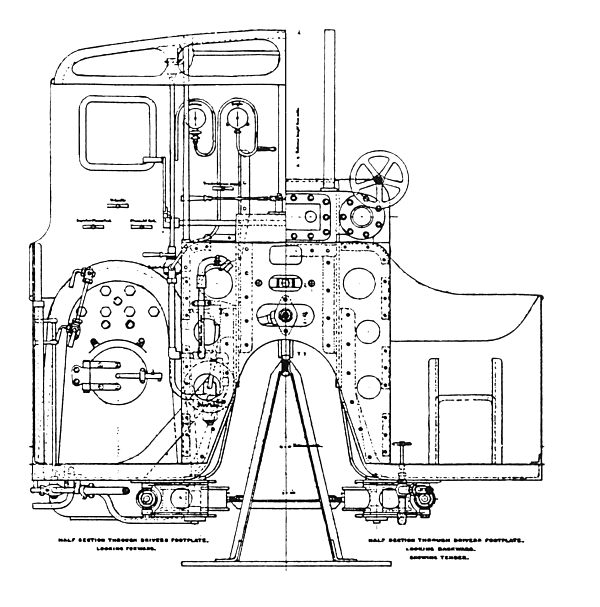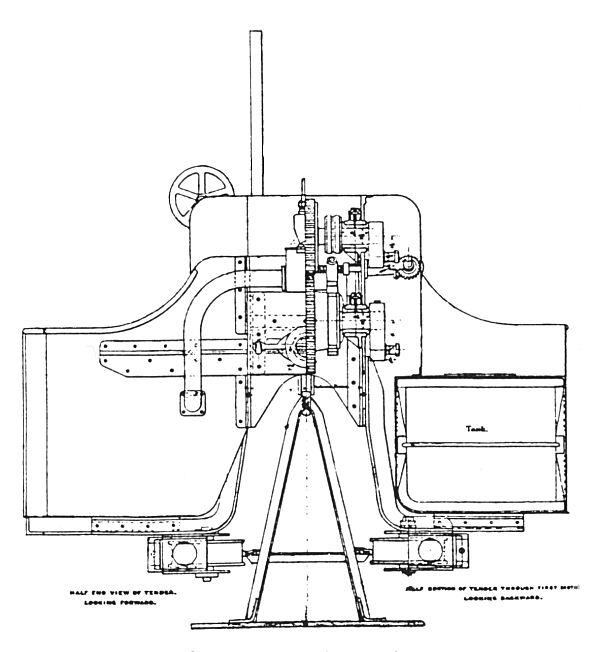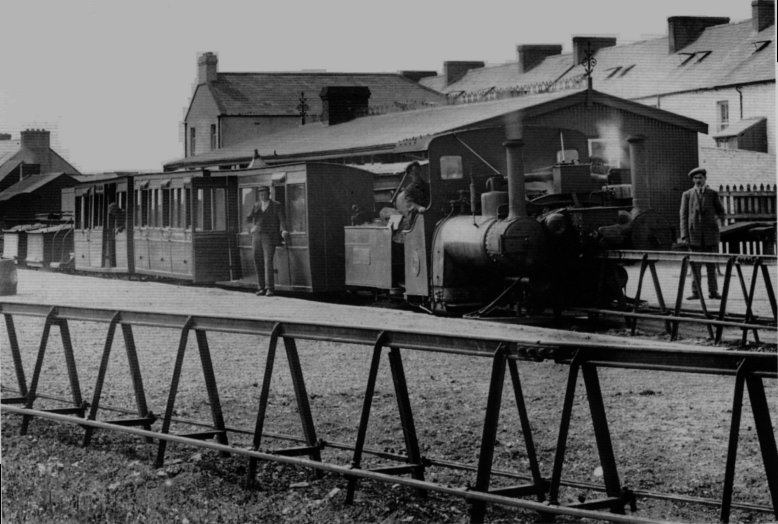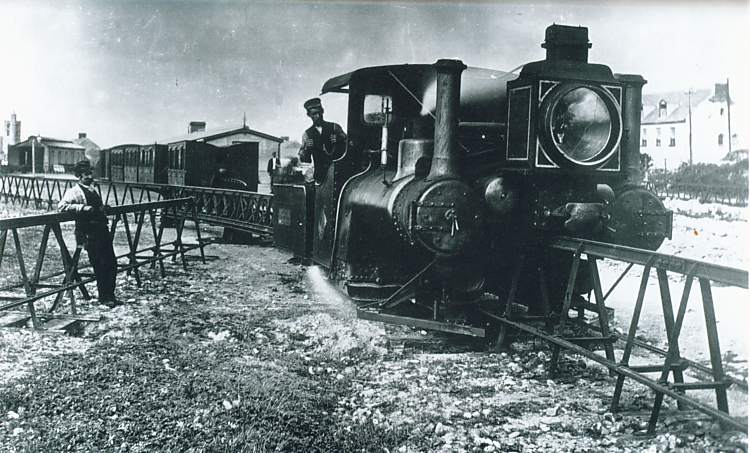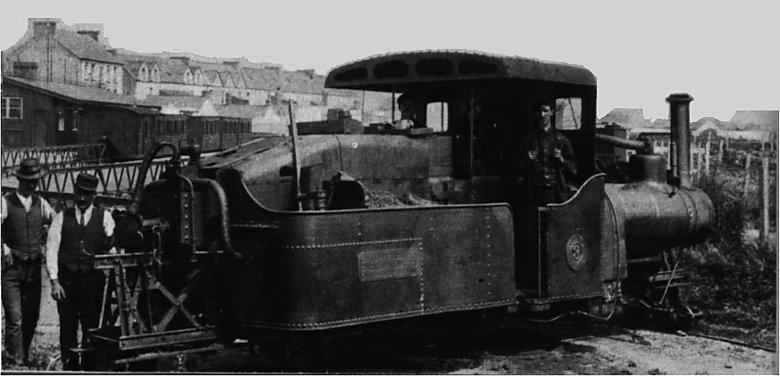
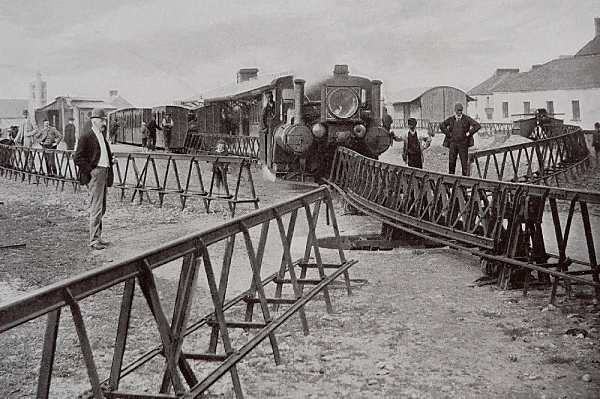 |
| Left: How to cross tracks with a Lartigue; a loco moves onto the turntable at Ballybunnion station.
This photograph was reproduced as an etching several times, including in the French journal La Nature.
Picture courtesy of Alan Reynolds
|
 |
| Left: A film of the Lartigue in operation exists
It commences with one of the locomotives lurching somewhat as it leaves the engine-shed, then moves on to show the unloading and loading of passengers on a mixed passenger/freight run. It closes with an example of the lifting bridges that crossed the railway. Judging by the cloche hats on the ladies, it must have been made around 1920-30.
See it on YouTube.
|
The contemporary description of the Lartigue railway reproduced below comes from the 10 January 1920 issue of The New Illustrated, a weekly that began in 1914 as The War Illustrated:
AN UNKNOWN BRITISH RAILWAY: BY S T JAMES
"There are in this world of ours a remarkably high number of freakish
transport concerns labelled as "railways" and one of the most peculiar of
them is the Listowel and Ballybunion line, in the county of Kerry, Ireland.
This railway was built in 1888 for the special purpose of developing
Ballybunion (Lord Kitchener's birthplace) as a seaside resort. It took only
six months to build, is nine and a half miles long, and cost three thousand
pounds per mile, an extremely low figure, as many other British railway
companies could testify.
Instead of a gleaming metal track, the permanent-way consists of light
A-shaped trestles, about three and a half feet high, and placed across the
ground at about the same distance one from another. The object of a
permanent-way of this description is to obviate the heavy expense of
levelling the ground. By slightly varying the lengths of the trestles the
line can run fairly evenly over the grass, up hill and down dale.
A heavy rail runs from the apex of each A-shaped trestle, whilst two lighter
"guide rails" are attached about two and a half feet lower down each side;
but the engine and carriages run on the top rail, which bears all the
weight. The effect is something like that of a series of short, squat pegs
jammed across a clothes-line.
There are three locomotives, but only one is used at a time. The two most
efficient ones work a week each in turn, while the third is kept In reserve
for special occasions.
MONORAIL ENGINES
Naturally, having to run on a single elevated line of rail, the engines have
to be so constructed that they will balance, or, to use naval language,
maintain an even keel. This is ensured by making each locomotive with two
boilers, two funnels, two tenders, two smoke-boxes, stacks, etc. In fact, a
Listowel and Ballybunion locomotive is just like two ordinary ones joined
together in the middle. Each has two wheels coupled together and fitted
between the twin boilers, together with four smaller wheels at the sides to
engage the two check-rails. It is claimed that these engines can haul a
load of two hundred and forty tons over the trestleway at thirty miles per
hour.
The passenger coaches and goods waggons are, of course, built on similar
lines each consisting of a double interior and as it is necessary to have
some connection between each half of the passenger vehicles, a stairway is
provided via which travellers can pass from one side to the other, over the
top of the coach.
Altogether, there are eleven passenger coaches, providing seating
accommodation for fifty-two first-class and two hundred and twenty-eight
third-class passengers. There are also seventeen sand waggons and five
goods waggons, with two brake-vans. Truly an imposing array of
rolling-stock.
Naturally enough, the level crossings over which this line runs are peculiar
affairs. That portion of the trestle-way which obstructs the road is bolted
to a turn-table, and the turn-table being moved swings the permanent-way
round at right angles to open the road for the passage of horses, etc.
Afterwards, the line is turned back into position, bolted there, and then
the train may amble along as soon as it likes.
Perhaps the most amusing thing of all to English visitors is the shunting.
The various sidings on which vehicles are to be arranged, or "marshalled",
are all disconnected from the main line, and before a vehicle can be pushed
on or drawn from off such a siding, a portion of trestle-way must be swung
into position to connect the two.
Imagine, then, the nature of each shunting operation. A waggon has been
placed on line No. 1. The next vehicle is for line No. 3. So the trestle
track has to be unbolted from the ground, disconnected with line No. 1,
moved into a position that will connect it with line No.3, connected up,
bolted down, and then - well, there we are! How very different to our
method of merely pulling over a lever to alter the points.
Connecting with the Ballybunion terminus of the line is a short branch of
half a mile whereon sand waggons are loaded. This branch line is cleared
once a day, and since it runs along the main road, the trestle track can
only be allowed to remain fixed in a position during the hour or so when the
train is running along it. After that it is uprooted and left lying along
the roadside for the rest of the day. Just before the train comes along on
the morrow, a railway official will arrive to reconstruct the permanent-way.
A ride over the Listowel and Ballybunion Railway is an experience not likely
to be forgotten. As the time for departure draws near, the loading of the
passengers has to be adjusted in order that the train shall balance evenly.
The weight of travellers in the left half must be approximately equal to the
weight of those in the right half.
BALANCING THE TRAIN
Guard and stationmaster jointly arrange the balancing, walking each down one
side and calling to the other the number in each half of the coach. If
perchance there should be twenty in one half and only twelve on the other,
four of the twenty have to leave and proceed via the portable bridge to the
other side of the train.
Local residents assert that one day there arrived at the station just before
the train started two engaged couples, a very fat pair and a very lean pair.
The first-class carriages, for which these people held tickets, only hold
two on each side, and the two fat ones climbed in one half, while the two
thin ones sat in the other. This, of course, quite upset the balance of the
train, and eventually someone - it needed an Irishman, too - intimated to
the devoted lovers that they must part company. So a fat male and a thin
female exchanged places, and so well did the alteration suit, that when the
train reached its destination the change of partners had been made
permanent.*
It is not a little surprising to find that a freak line of this description
pays its way so much better than the up-to-date railways with which we are
accustomed to deal. Yet such is actually the case. In normal times the
annual receipts total close upon seven thousand pounds, whilst the
expenditure is six thousand pounds, enabling payment of a dividend of,
roughly, four per cent.
There are no stations such as we are accustomed to, but a marked-out piece
of land serves. The General Manager's office is about the size of an
ordinary platelayer's cabin, and this official undertakes every
administrative duty connected with the line, being Passenger, Goods, and
Locomotive Manager, Permanent-way Inspector, and Lord High Admiral of
everything."
* A saucy joke for the times, but S T James unwittingly relates it wrongly-
surely the two men thus ended up together on one side and the women on the
other?

Amazingly, the Listowel & Ballybunion railway has been partly rebuilt. It only has one locomotive, and that is powered by a diesel engine, but you can't have everything. See more about it here.

THE FEURS-PANISSIÈRES LINE
 |
| Left: The Feurs-Panissières Line.
The cheap seats are on top of the carriages.
The Feurs-Panissières locos were not made by Hunslet, but by B
|
 |
| Left: The Feurs-Panissières Line
Wire has been added to keep the upstairs passengers inside the loading gauge. (I assume)
|

THE MAGNESIUM MONORAIL: 1924

|
| The Magnesium Monorail: 1924
Probably the last Lartigue monorail was built in the Mojave Desert, USA, by the Sierra Salt Corporation in California. It carried magnesium salts from their mine in the Crystal
Hills to the railhead at Trona, across difficult terrain in the Salinas Valley. (Inyo County) The line was successful but only lasted 2 years before modern developments in magnesium extraction put the mine out of business.
No details of the locomotive can be seen here- in fact it is not even clear if there is one in the picture. The umbrella to keep the sun off is however clearly visible.
|

|
| The Magnesium Monorail: 1924
Another picture where no steam locomotive is visible. At first I thought that this railway was worked by cable haulage, but there looks to be a petrol engine installed in the first car. The engine cover can be seen between the umbrella and the man's legs.
Picture courtesy of G Dombroski
|
When I started this page, I was amazed to find even one photo of the Lartigue locomotive. It took a long time to unearth the few you see here. But now this remarkable book tells you all. Available from:
www.transportdiversions.com
29/11/07 Unfortunately I have just been told that this book is now out of print. Haven't contacted the publishers to check.
| 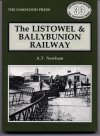
|









